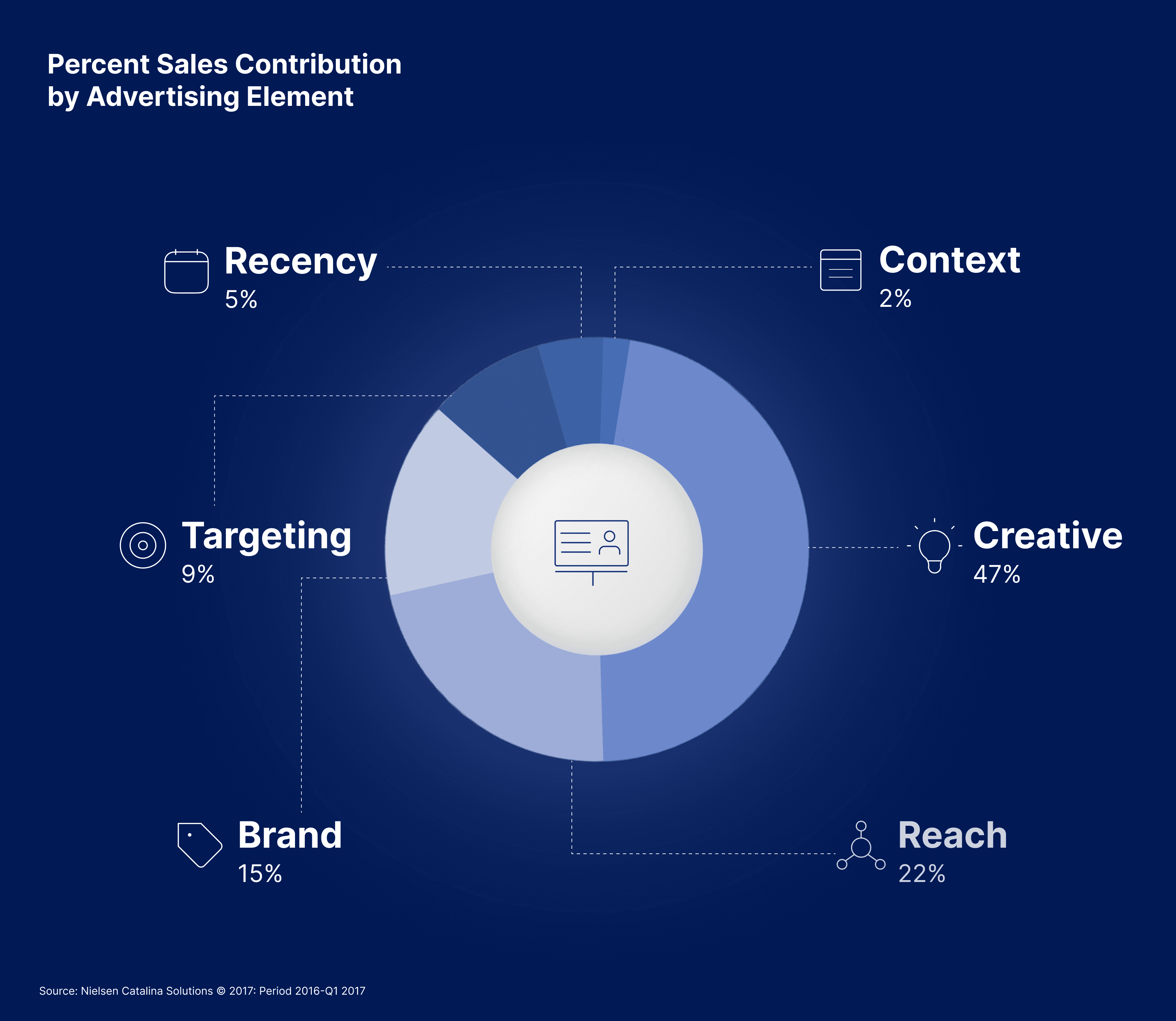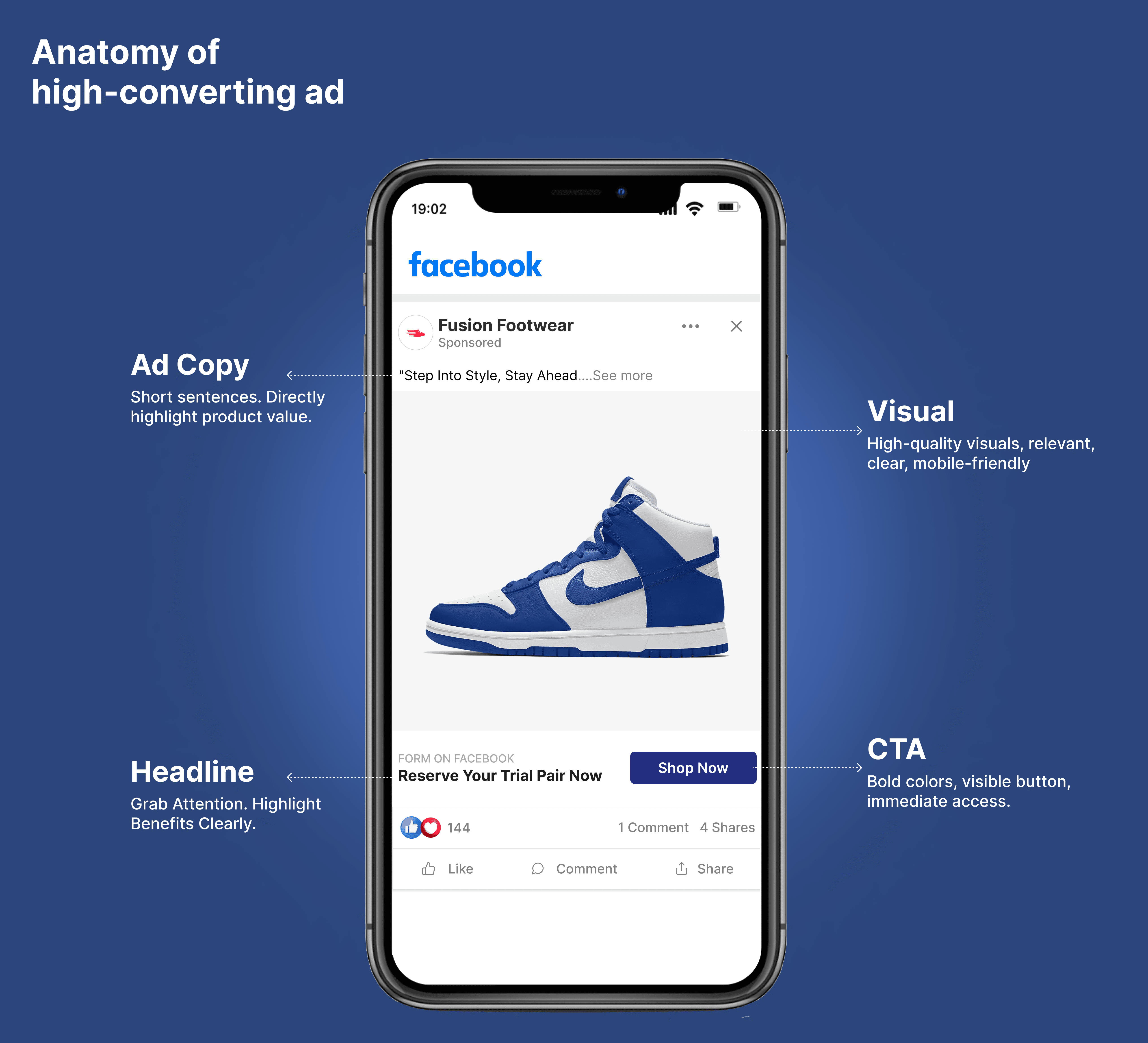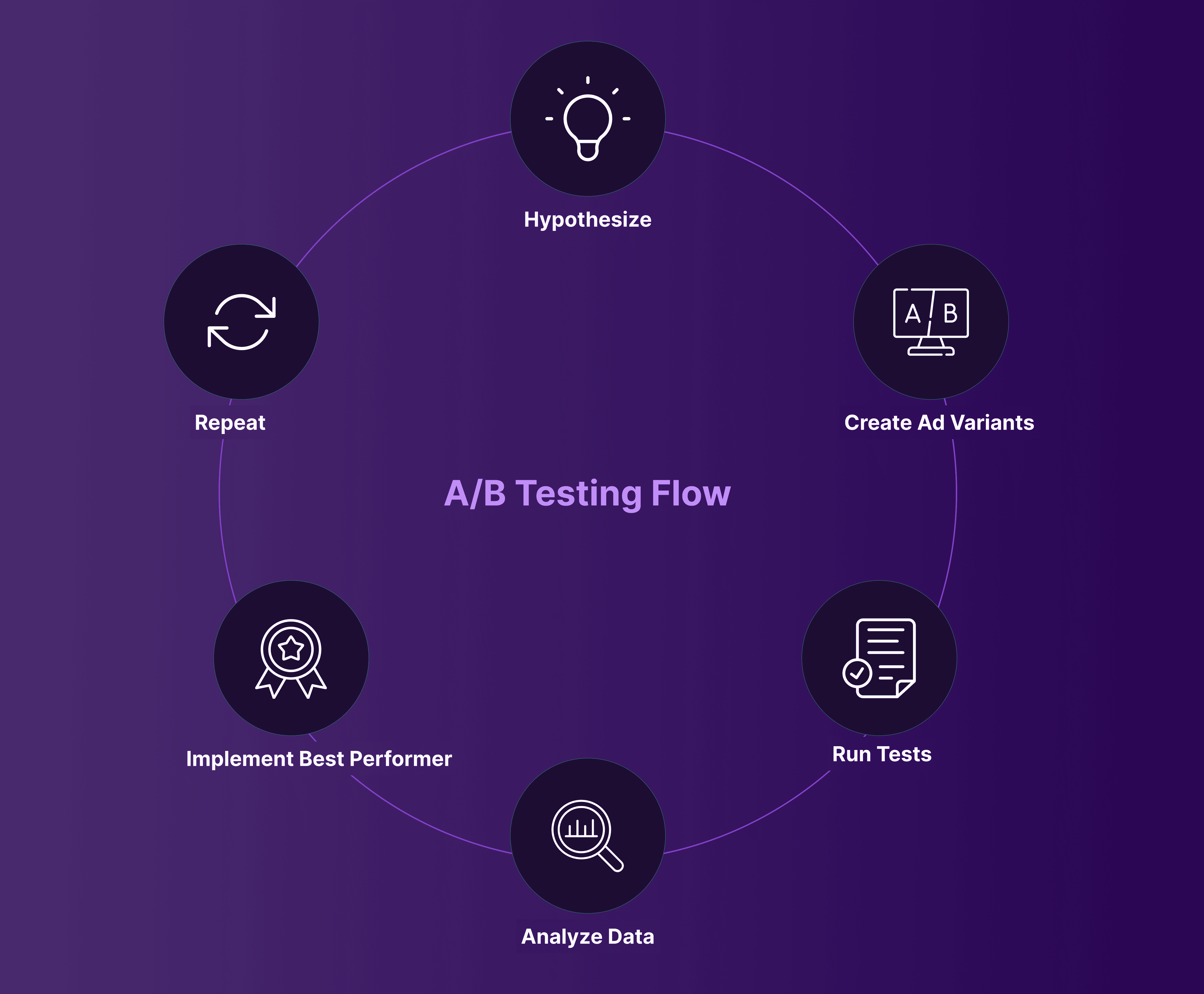Tutorials
Designing High-Converting Ads for Performance Marketing Campaigns
Jan 22, 2025

Abhimanyu Atri
Marketing Associate
Introduction
In performance marketing, ad creatives are undeniably one of the most critical factors that can make or break a campaign’s success. While targeting, bid strategies, and platform algorithms play substantial roles, none can overcome the negative impact of poor creatives. Conversely, an engaging visual, compelling copy and strategic design can amplify the effect of precise targeting and bidding optimization. A Facebook for Business study found that 56% of a brand’s sales lift from digital ads can be attributed to the creatives' quality alone. This underscores the urgent need for marketers to craft high-converting creatives that resonate with the right audience at the right moment.
Why Ad Creative Matters in Performance Marketing
Performance marketing is centered on measurable outcomes—clicks, leads, sales, app installs, and other metrics. Marketers often pay on a cost-per-acquisition or cost-per-click model, so every ad creative must work as hard as possible to drive results.
First Impressions Count: Online users scroll through feeds or search listings at high speeds. Advertisements only have a split second to grab their attention and communicate relevance. An ad that instantly resonates can stop the scroll; a poorly crafted one gets ignored.
Differentiation in Competitive Spaces: When marketing on high-volume platforms such as Facebook, Instagram, and Google, you’re competing with countless other advertisers. Strong, unique creative helps separate your product or service from a sea of similar offerings.
Creative Complements Targeting: No matter how sophisticated your targeting is, an unappealing design or confusing message will hamper campaign performance. Conversely, ad creatives that are both hyper-relevant and visually striking can significantly improve CTR and conversion rates.
Brand Recognition and Trust: Consistent use of brand elements (logo, color palette, typography) in your creatives builds brand recognition. A recognizable, trustworthy brand identity often leads to higher engagement and greater ROI over time.

Figure 1. Contribution of Ad Element to Sales
The Key Elements of High-Converting Ad Creatives
At a foundational level, ad creatives typically involve four main components: the headline, the visual (image or video), the body copy, and the call-to-action (CTA). Each part plays a specific role in capturing user interest, conveying benefits, and nudging them toward conversion.

Figure 2. Anatomy of an Ad
Headline
Clarity Over Cleverness: A headline must instantly communicate the benefit or core message. While puns or humor can work, clarity should never be sacrificed.
Highlight the Value Proposition: If your product or offer solves a problem, lead with that. For example, “Save 50% on Premium Running Shoes” states both the product and the benefit.
Concise Formatting: Keep it short (around 25 characters if possible) so it fits neatly in most ad placements without truncation.
Visual (Image or Video)
Use High-Quality Media: Blurry or pixelated visuals immediately undermine brand credibility. Understand the size and aspect ratio of where the ad will be displayed and design the creatives accordingly.
Focus on the Product or Key Message: In e-commerce, highlight the product front and center. For a service, consider using conceptual visuals that evoke the desired emotion or outcome.
Video Thumbnails: If you’re using video ads, ensure the first few seconds hook the viewer. Most users decide within 1-3 seconds whether to keep watching or scroll past.
Mobile-Friendly: Vertical or square formats often perform better on mobile platforms. A Facebook IQ report showed that vertical video increases brand lift by 13% compared to horizontal formats in mobile feeds.
Body Copy
Segmentation and Relevance: Tailor messaging to each audience segment. If you’re remarketing to cart abandoners, reference their previously viewed products or the shipping discount they’re missing out on.
Concise and Action-Oriented: Online readers have short attention spans. Keep sentences short, direct, and focused on the benefits.
Address Objections: If you anticipate consumer hesitations (price, quality, or complexity), preemptively address them in the copy.
Call-to-Action (CTA)
Clarity and Urgency: “Shop Now,” “Download Today,” “Claim Your Free Trial.” Clear, action-oriented phrasing can significantly lift conversions.
Visible Placement: Make the CTA button or link stand out through color contrast and size.
Customization: Align the CTA text with the offer. For example, “Get My Free E-Book” outperforms generic copy like “Click Here.”
Copywriting Best Practices for Performance Marketing
Copywriting is where human psychology meets marketing strategy. The right words can influence users to take a specific action, address pain points, and reinforce trust. Below are some nuanced copywriting tips that can significantly boost performance.
Use the ‘So What?’ Test: After writing a key benefit, ask “So what?” If the answer is not compelling or doesn’t highlight a deeper emotional or practical value, refine the statement further.
For instance, “Our software automates your financial reporting” might not be enough. “Our software automates your financial reporting, saving you up to 10 hours per week so you can focus on scaling your business” is more compelling.Leverage FOMO and Social Proof:
FOMO (Fear of Missing Out): Limited-time offers, countdown timers, or highlighting limited stock can push hesitant buyers to act.
Social Proof: Mention the number of customers, testimonials, or review snippets. For instance, “Join 50,000+ Satisfied Homeowners” appeals to the bandwagon effect in psychology.
Focus on the Second Person (You/Your): Speaking directly to the reader personalizes the experience. Instead of “We offer top-tier marketing solutions,” try “Take your brand to the next level with solutions designed specifically for you.”
Keep Language Simple and Jargon-Free: Technical terms can alienate potential customers unless you’re in a highly specialized B2B field. Even then, strive for clarity, supporting complicated concepts with easy-to-understand examples.
Test Different Angles:
Benefit-Driven Copy: “Get 2x faster results.”
Pain-Driven Copy: “Tired of slow results? We can help.”
Data-Driven Copy: “Proven to reduce workload by 40% within two weeks.”
Different angles resonate with different audience segments, so consider A/B testing your copy variants to see which approach yields the best CTR and conversions.
Design & Visual Considerations
An ad’s design converges color, layout, typography, and imagery to produce an immediate emotional response. Good design can capture attention and guide a user’s eyes to the most critical information.
Hierarchy of Information
Place the primary message or offer in the most prominent spot, such as the center or top of the ad.
Keep secondary information—such as disclaimers or additional details—off to the side or in smaller text.
Ensure the CTA is visually distinct (e.g., a button with a contrasting color).
Consistency with Branding
Color Palette: Stick to a consistent set of brand colors. This not only reinforces brand recognition but also prevents the ad from looking disjointed.
Fonts: Limit the use of typefaces to keep the design clean and easy to read. Consistency in typography fosters brand cohesion.
Readable Text
The text must be large and clear enough on mobile devices, where the majority of ad impressions occur.
Avoid placing too much text over images if it compromises clarity.
Visual Contrast
Contrast between text and background ensures readability.
High contrast can also make certain elements “pop,” drawing the user’s eye to key points.
According to a QuickSprout study, using color contrast on CTAs can increase click-through rates by over 30%.
Color Psychology & Layout
Colors evoke emotional and psychological reactions in viewers, which can influence how they perceive an offer or brand. Layout, on the other hand, dictates how all elements fit together to guide the viewer’s journey through the ad.
Color Psychology
A CCICOLOR research piece highlighted that 85% of consumers cite color as a primary reason for buying a particular product. While this statistic is typically referenced to product packaging, it underscores the general importance of strategic color choices in marketing.
Red: Often associated with urgency, excitement, or danger. Can be used for clearance sales, limited-time offers, or urgent CTAs.
Blue: Connotes trust, stability, and calm. Many financial and tech brands use blue to signal reliability.
Green: Symbolizes growth, health, and wealth. It’s commonly used for eco-friendly products or financial growth solutions.
Yellow/Orange: Radiate energy, optimism, and creativity. They can be attention-grabbing but should be paired carefully with neutral tones to avoid overwhelming the viewer.
Layout Strategies
Z-Pattern / F-Pattern: Website visitors often read from left to right, top to bottom. Placing important elements along the “Z” or “F” scanning paths can improve content visibility.
Rule of Thirds: Visually dividing the ad into three sections horizontally and vertically can create balanced compositions. Placing the focal point (e.g., product image or key offer) along these grid lines often leads to more appealing visuals.
Whitespace: Also known as negative space, whitespace improves readability and comprehension. It helps elements stand out and keeps the ad from looking cluttered.
Platform-Specific Ad Format Guidelines
Different advertising channels—Facebook, Instagram, Google Display, YouTube, LinkedIn, and TikTok—feature unique ad placements and best practices. Below is a brief rundown to help you tailor your creative to the nuances of each platform.
TikTok, Facebook, and Instagram
Image/Video Ratios:
Facebook Feed Images & Videos: 1:1 or 4:5 for mobile newsfeeds.
Instagram Feed: 1:1 is common, though 4:5 is also effective.
Stories/Reels: Vertical 9:16 for full-screen immersive experiences.
Text Overlay:
While Facebook has dropped the strict “20% text rule,” ads with minimal text often still perform better.
Strive for a strong visual focus with complementary short text or headlines.
Creative & CTA Buttons:
Facebook and Instagram automatically populate CTA buttons (“Shop Now,” “Learn More,” etc.). Test different CTA texts for better conversions.
Google Display Network (GDN) and YouTube
Responsive Display Ads:
Google Ads automatically resizes and formats images and text across various placements.
Provide multiple headlines, descriptions, and images to let Google optimize combinations for performance.
Image Guidelines:
Keep file size under 150 KB for GDN.
Use crisp images that highlight brand or product features.
YouTube Video Ads:
Hook viewers within the first 5 seconds.
Employ subtitles for viewers watching on mute.
Consider using annotation or overlay CTA to drive direct actions.
LinkedIn
Professional Tone:
LinkedIn users often look for B2B, career-related, or professional development content.
Emphasize value propositions related to productivity, ROI, or career advancement.
Ad Formats:
Single image ads, carousel ads, and video ads.
For Sponsored InMail/Messaging Ads, craft concise subject lines and clear CTAs within the message body.
Design:
Maintain a polished, professional appearance in line with LinkedIn’s user expectations.
Focus on how your solution solves specific business challenges.
TikTok
Vertical Videos (9:16):
Content should appear native to the platform (authentic and dynamic).
Overly polished or “traditional” ad styles can seem out of place.
Sound On:
Unlike other platforms where viewers might watch on mute, TikTok is heavily audio-driven.
Include catchy music or voiceovers relevant to your brand and audience.
Short and Engaging:
Recommended ad length is 9-15 seconds.
Use fast cuts, text overlays, and emotive visuals to grab attention quickly.
Testing and Iteration to Optimize Creatives
Even the most carefully designed ad doesn’t always succeed on the first try. Continuous A/B testing and data-driven optimization separate mediocre campaigns from outstanding ones.

Figure 3. Testing flow for Ad Creatives
A/B Test One Variable at a Time
Change only the headline, only the CTA button color, or only the primary image.
Testing multiple variables in one go makes it difficult to pinpoint which change drove results.
Use Metrics that Matter
CTR: A strong indicator of how well your ad grabs attention and resonates with the audience.
Conversion Rate: Determines if the traffic you’re driving is high quality and if the ad promise aligns with the landing page experience.
Cost Per Acquisition (CPA) or Return on Ad Spend (ROAS): Ultimately, you need to tie campaign success to business outcomes.
Iterate Based on Insights
If your CTR is high, but conversions are low, consider adjusting the landing page or the ad’s messaging around the offer.
If your CTR is low, focus on making the creative more eye-catching and relevant.
If you see strong engagement on certain audience segments, refine your targeting to concentrate on those groups.
Leverage Platform Analytics
Facebook’s Ads Manager: Break down results by age, gender, placement, or device.
Google Ads: Keyword performance, search term reports, audience insights.
LinkedIn: Industry, job function, seniority.
TikTok: Audience demographics, average watch time, and engagement rates.
Conclusion
Designing high-converting ad creatives demands a blend of persuasive copywriting, strategic design, an understanding of human psychology, and a strong grasp of platform-specific best practices.
Remember the following key insights:
Simplicity and Clarity: A direct, benefit-focused message often outperforms a vague, overly clever ad.
Emotional Resonance: Use color, imagery, and strategic copy to connect with the audience’s desires, fears, or aspirations.
Data-Driven Iteration: Continuously test and refine. A/B testing is essential to discovering what resonates most strongly with your target segments.
Platform Nuances: Each channel—Facebook, Instagram, Google, LinkedIn, TikTok—has its own specifications and audience expectations. Adhering to these increases the probability of success.
As you gather more data on your campaigns, fine-tune your creative elements accordingly. This iterative improvement leads to consistent ROI growth over time, forging higher-performing ads and stronger, long-lasting brand connections with your audience.
Introduction
In performance marketing, ad creatives are undeniably one of the most critical factors that can make or break a campaign’s success. While targeting, bid strategies, and platform algorithms play substantial roles, none can overcome the negative impact of poor creatives. Conversely, an engaging visual, compelling copy and strategic design can amplify the effect of precise targeting and bidding optimization. A Facebook for Business study found that 56% of a brand’s sales lift from digital ads can be attributed to the creatives' quality alone. This underscores the urgent need for marketers to craft high-converting creatives that resonate with the right audience at the right moment.
Why Ad Creative Matters in Performance Marketing
Performance marketing is centered on measurable outcomes—clicks, leads, sales, app installs, and other metrics. Marketers often pay on a cost-per-acquisition or cost-per-click model, so every ad creative must work as hard as possible to drive results.
First Impressions Count: Online users scroll through feeds or search listings at high speeds. Advertisements only have a split second to grab their attention and communicate relevance. An ad that instantly resonates can stop the scroll; a poorly crafted one gets ignored.
Differentiation in Competitive Spaces: When marketing on high-volume platforms such as Facebook, Instagram, and Google, you’re competing with countless other advertisers. Strong, unique creative helps separate your product or service from a sea of similar offerings.
Creative Complements Targeting: No matter how sophisticated your targeting is, an unappealing design or confusing message will hamper campaign performance. Conversely, ad creatives that are both hyper-relevant and visually striking can significantly improve CTR and conversion rates.
Brand Recognition and Trust: Consistent use of brand elements (logo, color palette, typography) in your creatives builds brand recognition. A recognizable, trustworthy brand identity often leads to higher engagement and greater ROI over time.

Figure 1. Contribution of Ad Element to Sales
The Key Elements of High-Converting Ad Creatives
At a foundational level, ad creatives typically involve four main components: the headline, the visual (image or video), the body copy, and the call-to-action (CTA). Each part plays a specific role in capturing user interest, conveying benefits, and nudging them toward conversion.

Figure 2. Anatomy of an Ad
Headline
Clarity Over Cleverness: A headline must instantly communicate the benefit or core message. While puns or humor can work, clarity should never be sacrificed.
Highlight the Value Proposition: If your product or offer solves a problem, lead with that. For example, “Save 50% on Premium Running Shoes” states both the product and the benefit.
Concise Formatting: Keep it short (around 25 characters if possible) so it fits neatly in most ad placements without truncation.
Visual (Image or Video)
Use High-Quality Media: Blurry or pixelated visuals immediately undermine brand credibility. Understand the size and aspect ratio of where the ad will be displayed and design the creatives accordingly.
Focus on the Product or Key Message: In e-commerce, highlight the product front and center. For a service, consider using conceptual visuals that evoke the desired emotion or outcome.
Video Thumbnails: If you’re using video ads, ensure the first few seconds hook the viewer. Most users decide within 1-3 seconds whether to keep watching or scroll past.
Mobile-Friendly: Vertical or square formats often perform better on mobile platforms. A Facebook IQ report showed that vertical video increases brand lift by 13% compared to horizontal formats in mobile feeds.
Body Copy
Segmentation and Relevance: Tailor messaging to each audience segment. If you’re remarketing to cart abandoners, reference their previously viewed products or the shipping discount they’re missing out on.
Concise and Action-Oriented: Online readers have short attention spans. Keep sentences short, direct, and focused on the benefits.
Address Objections: If you anticipate consumer hesitations (price, quality, or complexity), preemptively address them in the copy.
Call-to-Action (CTA)
Clarity and Urgency: “Shop Now,” “Download Today,” “Claim Your Free Trial.” Clear, action-oriented phrasing can significantly lift conversions.
Visible Placement: Make the CTA button or link stand out through color contrast and size.
Customization: Align the CTA text with the offer. For example, “Get My Free E-Book” outperforms generic copy like “Click Here.”
Copywriting Best Practices for Performance Marketing
Copywriting is where human psychology meets marketing strategy. The right words can influence users to take a specific action, address pain points, and reinforce trust. Below are some nuanced copywriting tips that can significantly boost performance.
Use the ‘So What?’ Test: After writing a key benefit, ask “So what?” If the answer is not compelling or doesn’t highlight a deeper emotional or practical value, refine the statement further.
For instance, “Our software automates your financial reporting” might not be enough. “Our software automates your financial reporting, saving you up to 10 hours per week so you can focus on scaling your business” is more compelling.Leverage FOMO and Social Proof:
FOMO (Fear of Missing Out): Limited-time offers, countdown timers, or highlighting limited stock can push hesitant buyers to act.
Social Proof: Mention the number of customers, testimonials, or review snippets. For instance, “Join 50,000+ Satisfied Homeowners” appeals to the bandwagon effect in psychology.
Focus on the Second Person (You/Your): Speaking directly to the reader personalizes the experience. Instead of “We offer top-tier marketing solutions,” try “Take your brand to the next level with solutions designed specifically for you.”
Keep Language Simple and Jargon-Free: Technical terms can alienate potential customers unless you’re in a highly specialized B2B field. Even then, strive for clarity, supporting complicated concepts with easy-to-understand examples.
Test Different Angles:
Benefit-Driven Copy: “Get 2x faster results.”
Pain-Driven Copy: “Tired of slow results? We can help.”
Data-Driven Copy: “Proven to reduce workload by 40% within two weeks.”
Different angles resonate with different audience segments, so consider A/B testing your copy variants to see which approach yields the best CTR and conversions.
Design & Visual Considerations
An ad’s design converges color, layout, typography, and imagery to produce an immediate emotional response. Good design can capture attention and guide a user’s eyes to the most critical information.
Hierarchy of Information
Place the primary message or offer in the most prominent spot, such as the center or top of the ad.
Keep secondary information—such as disclaimers or additional details—off to the side or in smaller text.
Ensure the CTA is visually distinct (e.g., a button with a contrasting color).
Consistency with Branding
Color Palette: Stick to a consistent set of brand colors. This not only reinforces brand recognition but also prevents the ad from looking disjointed.
Fonts: Limit the use of typefaces to keep the design clean and easy to read. Consistency in typography fosters brand cohesion.
Readable Text
The text must be large and clear enough on mobile devices, where the majority of ad impressions occur.
Avoid placing too much text over images if it compromises clarity.
Visual Contrast
Contrast between text and background ensures readability.
High contrast can also make certain elements “pop,” drawing the user’s eye to key points.
According to a QuickSprout study, using color contrast on CTAs can increase click-through rates by over 30%.
Color Psychology & Layout
Colors evoke emotional and psychological reactions in viewers, which can influence how they perceive an offer or brand. Layout, on the other hand, dictates how all elements fit together to guide the viewer’s journey through the ad.
Color Psychology
A CCICOLOR research piece highlighted that 85% of consumers cite color as a primary reason for buying a particular product. While this statistic is typically referenced to product packaging, it underscores the general importance of strategic color choices in marketing.
Red: Often associated with urgency, excitement, or danger. Can be used for clearance sales, limited-time offers, or urgent CTAs.
Blue: Connotes trust, stability, and calm. Many financial and tech brands use blue to signal reliability.
Green: Symbolizes growth, health, and wealth. It’s commonly used for eco-friendly products or financial growth solutions.
Yellow/Orange: Radiate energy, optimism, and creativity. They can be attention-grabbing but should be paired carefully with neutral tones to avoid overwhelming the viewer.
Layout Strategies
Z-Pattern / F-Pattern: Website visitors often read from left to right, top to bottom. Placing important elements along the “Z” or “F” scanning paths can improve content visibility.
Rule of Thirds: Visually dividing the ad into three sections horizontally and vertically can create balanced compositions. Placing the focal point (e.g., product image or key offer) along these grid lines often leads to more appealing visuals.
Whitespace: Also known as negative space, whitespace improves readability and comprehension. It helps elements stand out and keeps the ad from looking cluttered.
Platform-Specific Ad Format Guidelines
Different advertising channels—Facebook, Instagram, Google Display, YouTube, LinkedIn, and TikTok—feature unique ad placements and best practices. Below is a brief rundown to help you tailor your creative to the nuances of each platform.
TikTok, Facebook, and Instagram
Image/Video Ratios:
Facebook Feed Images & Videos: 1:1 or 4:5 for mobile newsfeeds.
Instagram Feed: 1:1 is common, though 4:5 is also effective.
Stories/Reels: Vertical 9:16 for full-screen immersive experiences.
Text Overlay:
While Facebook has dropped the strict “20% text rule,” ads with minimal text often still perform better.
Strive for a strong visual focus with complementary short text or headlines.
Creative & CTA Buttons:
Facebook and Instagram automatically populate CTA buttons (“Shop Now,” “Learn More,” etc.). Test different CTA texts for better conversions.
Google Display Network (GDN) and YouTube
Responsive Display Ads:
Google Ads automatically resizes and formats images and text across various placements.
Provide multiple headlines, descriptions, and images to let Google optimize combinations for performance.
Image Guidelines:
Keep file size under 150 KB for GDN.
Use crisp images that highlight brand or product features.
YouTube Video Ads:
Hook viewers within the first 5 seconds.
Employ subtitles for viewers watching on mute.
Consider using annotation or overlay CTA to drive direct actions.
LinkedIn
Professional Tone:
LinkedIn users often look for B2B, career-related, or professional development content.
Emphasize value propositions related to productivity, ROI, or career advancement.
Ad Formats:
Single image ads, carousel ads, and video ads.
For Sponsored InMail/Messaging Ads, craft concise subject lines and clear CTAs within the message body.
Design:
Maintain a polished, professional appearance in line with LinkedIn’s user expectations.
Focus on how your solution solves specific business challenges.
TikTok
Vertical Videos (9:16):
Content should appear native to the platform (authentic and dynamic).
Overly polished or “traditional” ad styles can seem out of place.
Sound On:
Unlike other platforms where viewers might watch on mute, TikTok is heavily audio-driven.
Include catchy music or voiceovers relevant to your brand and audience.
Short and Engaging:
Recommended ad length is 9-15 seconds.
Use fast cuts, text overlays, and emotive visuals to grab attention quickly.
Testing and Iteration to Optimize Creatives
Even the most carefully designed ad doesn’t always succeed on the first try. Continuous A/B testing and data-driven optimization separate mediocre campaigns from outstanding ones.

Figure 3. Testing flow for Ad Creatives
A/B Test One Variable at a Time
Change only the headline, only the CTA button color, or only the primary image.
Testing multiple variables in one go makes it difficult to pinpoint which change drove results.
Use Metrics that Matter
CTR: A strong indicator of how well your ad grabs attention and resonates with the audience.
Conversion Rate: Determines if the traffic you’re driving is high quality and if the ad promise aligns with the landing page experience.
Cost Per Acquisition (CPA) or Return on Ad Spend (ROAS): Ultimately, you need to tie campaign success to business outcomes.
Iterate Based on Insights
If your CTR is high, but conversions are low, consider adjusting the landing page or the ad’s messaging around the offer.
If your CTR is low, focus on making the creative more eye-catching and relevant.
If you see strong engagement on certain audience segments, refine your targeting to concentrate on those groups.
Leverage Platform Analytics
Facebook’s Ads Manager: Break down results by age, gender, placement, or device.
Google Ads: Keyword performance, search term reports, audience insights.
LinkedIn: Industry, job function, seniority.
TikTok: Audience demographics, average watch time, and engagement rates.
Conclusion
Designing high-converting ad creatives demands a blend of persuasive copywriting, strategic design, an understanding of human psychology, and a strong grasp of platform-specific best practices.
Remember the following key insights:
Simplicity and Clarity: A direct, benefit-focused message often outperforms a vague, overly clever ad.
Emotional Resonance: Use color, imagery, and strategic copy to connect with the audience’s desires, fears, or aspirations.
Data-Driven Iteration: Continuously test and refine. A/B testing is essential to discovering what resonates most strongly with your target segments.
Platform Nuances: Each channel—Facebook, Instagram, Google, LinkedIn, TikTok—has its own specifications and audience expectations. Adhering to these increases the probability of success.
As you gather more data on your campaigns, fine-tune your creative elements accordingly. This iterative improvement leads to consistent ROI growth over time, forging higher-performing ads and stronger, long-lasting brand connections with your audience.
Share:
Share:
Get Started Today
Experience the power of personalization for increasing engagement and conversions Request a demo now!

Get Started Today
Experience the power of personalization for increasing engagement and conversions Request a demo now!

Get Started Today
Experience the power of personalization for increasing engagement and conversions Request a demo now!

Get Started Today
Experience the power of personalization for increasing engagement and conversions Request a demo now!

Keep Reading
Load More






